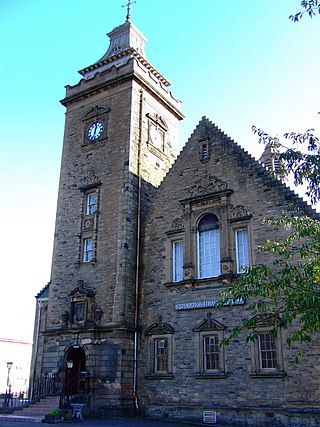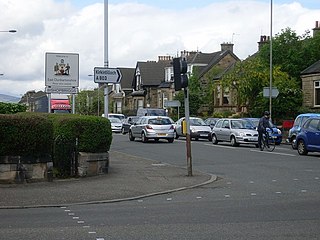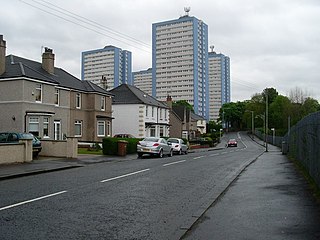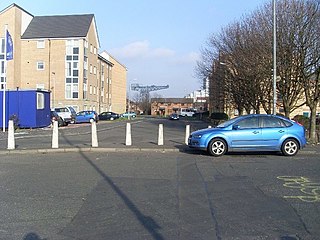
Scotstoun is an area of Glasgow, Scotland, west of Glasgow City Centre. It is bounded by Garscadden and Yoker to the west, Victoria Park, Jordanhill and Whiteinch to the east, Jordanhill to the north and the River Clyde to the south. At the heart of Scotstoun lies Scotstounhill, an enclave of late Victorian and post-war housing centred on Scotstounhill railway station. Scotstoun is home to BAE Systems Surface Ships, and to the Glasgow Warriors rugby team.

Pollokshaws is an area on the South side of the city of Glasgow, Scotland. It is bordered by the residential neighbourhoods of Auldhouse to the east, Eastwood and Hillpark to the south and Shawlands to the north, with the Glasgow South Western Line railway and the open lands of Pollok Country Park to the west. The White Cart Water flows through the area.

Springburn is an inner-city district in the north of the Scottish city of Glasgow, made up of generally working-class households.

Colston is a mostly residential area in the Scottish city of Glasgow; situated on the northern edge of the city, it is surrounded by the Glasgow areas of Milton to the west and Springburn to the east, and the town of Bishopbriggs to the north. The main road through Colston is the A803, which then becomes Kirkintilloch Road once past Colston to the north through Bishopbriggs.

Cowlairs is an area in the Scottish city of Glasgow, part of the wider Springburn district of the city. It is situated north of the River Clyde, between central Springburn to the east and Possilpark to the west.

Sandyhills is an area of the Scottish city of Glasgow. It is situated north of the River Clyde and has fallen within the Shettleston ward of Glasgow City Council since 2007.
Sighthill is a neighbourhood in the Scottish city of Glasgow. It is situated north of the River Clyde and is part of the wider Springburn district in the north of the city. It is bordered to the north by Cowlairs, to the east by the Springburn Bypass road and the Royston neighbourhood, to the west by the Glasgow to Edinburgh via Falkirk Line and to the south by the Townhead interchange of the M8 Motorway.

Scotstounhill is a small area situated in western Glasgow, between south Knightswood and Scotstoun. Housing is mainly in a terraced or villa style, although several high rise flats can be found in the area. These were built near to the site of the Scotstoun House mansion.

Kinning Park is a southern suburb of Glasgow, Scotland. It was formerly a separate police burgh between 1871 and 1905 before being absorbed by the city. In 1897, it had a population of 14,326.

Neilson and Company was a locomotive manufacturer in Glasgow, Scotland.

Stobhill Hospital is an Ambulatory Care and Diagnostic Hospital, located in Springburn in the north of Glasgow, Scotland. It serves the population of North Glasgow and part of East Dunbartonshire. It is managed by NHS Greater Glasgow and Clyde.

Duke Street is a street in Glasgow, Scotland. It runs from the city centre to the East End, from High Street through the residential district of Dennistoun, past The Forge Shopping Centre, meeting the Gallowgate, Tollcross Road and Westmuir Street to form a turreted Edwardian junction at Parkhead Cross. It takes its name from the Duke of Montrose.
George Johnston (1855–1945) was a Scottish engineer. He was the son of the Reverend James Johnston, of Springburn's United Presbyterian Church. George spent the early part of his career in locomotive engineering before designing and constructing Scotland's first automobile, the Mo-Car, which led to the formation of the Arrol-Johnston Car Company Ltd.
Walter Montgomerie Neilson was a Scottish locomotive and marine engineer and manufacturer. He was born in Glasgow, the son of James Beaumont Neilson, inventor of the hot blast furnace. Walter was trained as an engineer in the Oakbank Foundry run by his uncle John Neilson. He also worked in the St Rollox Engine Works in Glasgow. He was a President of the Institution of Engineers and Shipbuilders in Scotland and a member of the Institution of Civil Engineers. Outside his professional career, he was involved in local politics, the military, and Freemasonry.

Linn Park is an 82-hectare (200-acre) park in Glasgow, Scotland, surrounded by the suburbs of Cathcart, Muirend, Simshill, and Castlemilk, also bordering Netherlee in East Renfrewshire. It is Glasgow's third largest park, after Pollok Country Park and Dams to Darnley Country Park, although Dams to Darnley is half in East Renfrewshire. Both Linn and Pollok parks have the White Cart Water flowing through them. Some areas in the park are unsuitable for prams and the infirm.

Provan Hall is a historic place composed of two buildings built about the 15th century and situated in Auchinlea Park, Easterhouse, Glasgow. It is owned by the National Trust for Scotland and managed by Glasgow City Council. The two parallel buildings, enclosing a courtyard, are protected as a category A listed building.

Elder Park is a public park in the Govan area of Glasgow, Scotland, located a short distance south of the River Clyde, to the east of the Linthouse neighbourhood. It contains Elder Park Library, a boating pond, the original Fairfield farmhouse, and Linthouse Mansion portico.

The Springburn Winter Gardens is a large winter garden located at Springburn Park in the Springburn district of the Scottish city of Glasgow, constructed in 1900. The building was damaged in a storm and fell out of use in 1983 but was saved from planned demolition on 22 March 1985, when the Scottish Office included the structure on the Statutory List of Buildings of Special Architectural or Historic Interest, at category A.
Sighthill Cemetery is an active cemetery in central Glasgow, Scotland dating from 1840. It has an operational crematorium. It lies within the Sighthill neighbourhood on the A803 Springburn Road between Cowlairs Park and Petershill Park, north of Glasgow city centre, bounded to the north by Keppochhill Road.


















